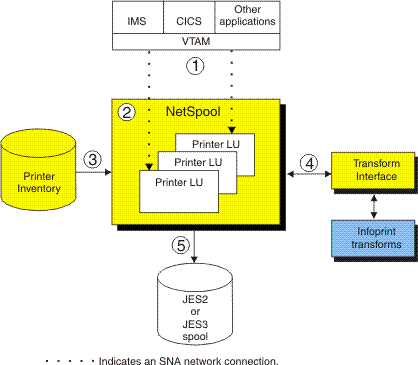NetSpool
The NetSpool component
of Infoprint Server
intercepts print data from VTAM® applications,
such as CICS® and IMS™; transforms the data streams
to EBCDIC line data, PCL, PDF, or other formats that the printer accepts; and
creates output data sets on the JES2 or JES3 spool. You can configure NetSpool so
that you do not need to change existing VTAM applications.
That is, existing VTAM applications
can send print requests to NetSpool in the same manner as they currently
send print requests to SNA network printers.
Figure 6 shows the steps that occur from the time VTAM applications send print requests
to NetSpool printer
logical units (LUs) until NetSpool allocates output data sets on the
JES spool. An explanation of each step follows.
Figure 6. NetSpool system diagram
- VTAM applications, such
as CICS or IMS, establish communication sessions with NetSpool printer
logical units (LUs) instead of with SNA-network printers. Each NetSpool printer
LU must be defined to VTAM as
an application logical-unit (LU).
NetSpool can process these types of VTAM data streams:
- SNA character string (SCS) data over an LU type 1 session
- 3270 data over an LU type 3 or LU type 0 session
- A binary data stream over an LU type 0, type 1, or type 3 session
- NetSpool runs
as a VTAM application on the
same or different z/OS system. NetSpool can process VTAM print requests sent to different NetSpool printer
LUs.
- The administrator defines each NetSpool printer LU in a printer definition
or printer pool definition in the Printer Inventory. NetSpool uses
information in the printer definition to format data into lines and
pages, transform data to a format that the printer accepts, and
group the data into output data sets.
- NetSpool can
transform SCS and 3270 data streams to EBCDIC line data or ASCII PCL
data streams. Also, it can use other transform products to convert
line data to other formats for printing or emailing.
- NetSpool dynamically
allocates output data sets on the JES2 or JES3 spool using JES allocation
parameters specified in the printer definition, including:
- JES work-selection parameters, such as class, forms name, and
destination. These parameters cause JES to direct the output data
sets to the correct program, such as IP PrintWay™ or PSF.
- Advanced Function Presentation (AFP) parameters,
such as the name of a form definition and page definition. PSF can
use these parameters when printing data on AFP printers.
- Distribution information, such as name and address, which can
be printed on output header pages.
Additional functions that NetSpool provides are:
- Transforms
NetSpool can transform data to line data or
PCL format without using a separate transform product. It can:
- Transform SCS and 3270 data streams into line data streams. Line
data can be printed on AFP printers.
- Transform SCS and 3270 data streams into PCL data streams. PCL
data can be printed on network printers.
For information about how NetSpool transforms SCS and 3270
data streams to line or PCL format, see z/OS Infoprint Server User’s Guide.
NetSpool can
transform data to PDF or PostScript format
using one of the transform products described in Transforms.
(NetSpool first
transforms SCS and 3270 data to line data, and then uses the transform).
- Validation of print requests
NetSpool can
validate, with some exceptions, that the document can print as requested
on the selected printer. For example, NetSpool can reject documents that
are too large to print on the selected printer.
- Operator control
The operator can control NetSpool LUs
from Infoprint Central,
from the system console, or from extended MCS consoles. For example,
the operator can display the status of NetSpool LUs, stop them, and start
them.
The operator can use tools such as SDSF and Infoprint Central
to find output data sets that NetSpool writes to the JES spool. Infoprint Central
can display additional status such as whether the output data sets
(called print jobs) completed successfully,
were retained due to failed transmission to LAN printers, or were
deleted before printing.
- Broadcasting output
You can print output to several printers at
the same time. Also, you can print output and send it to email destinations
at the same time. To do this, the administrator creates a printer
pool definition in the Printer Inventory. When VTAM application data is submitted to a printer
pool definition, NetSpool creates
multiple output data sets on the JES spool.
- Exits and filters
System programmers can
write and install exits to customize NetSpool processing. NetSpool exits can add data to
the beginning of output data sets, map graphic escape characters to
other printable characters, and modify or delete transparent data
in SCS data streams. System programmers can also write filter programs
to provide their own data stream transforms.
- Binary data support
The administrator can request
in the printer definition that NetSpool treat the data stream as binary data. NetSpool writes
binary data to the output data set as variable length records without
formatting the data and without rejecting unsupported commands, orders,
or data. This function is useful if you want to pass through all data
without change and without including transparent (TRN) controls.
- Owner and job attribute support
VTAM application programmers can
embed the owner job attribute and other Infoprint Server
job attributes in the application's print data that is sent to NetSpool.
Application programmers might want to embed the owner job
attribute to help identify the owner of printed output or the user
to charge in an accounting system for printing jobs. Application programmers
might want to embed other job attributes, such as forms, page-definition, or form-definition.
Also, the administrator can specify a NetSpool default owner in the printer
definition.



|
 z/OS Infoprint Server Customization
z/OS Infoprint Server Customization
 z/OS Infoprint Server Customization
z/OS Infoprint Server Customization




 Copyright IBM Corporation 1990, 2014
Copyright IBM Corporation 1990, 2014